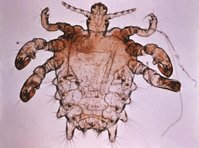STOWE, VT. -- Location, location, location. Where lice live on the body and how they got there are important considerations for optimal diagnosis and therapy, according to Dirk M. Elston, M.D.
While much attention is given to the identification and treatment of head lice because they are hyperendemic in many areas of the world, body lice and pubic lice are unique entities with specific treatment requirements, Dr. Elston said at a dermatology conference sponsored by the University of Vermont.
Similar in appearance to head lice, body lice (Pediculus humanus corporis) live in clothes rather than head hair. When they are not feeding, they hide in the seams of clothing and the folds of bedding. Scratch marks, hives, and small raised red bumps on the shoulders, torso, or buttocks are possible signs of body lice infestation.
Unlike head lice, body lice can be vectors for blood-borne diseases such as typhus and trench fever. In the United States, body louse infestation mainly affects homeless populations. Worldwide, infestations are common during times of war, in impoverished areas, and as a result of natural disasters that lead to crowded unsanitary conditions where clothing is not changed or laundered, said Dr. Elston of Geisinger Medical Center, Danville, Pa.
The treatment of body lice focuses on the infested clothing. Removing the clothing, laundering it in hot water, drying it on high heat, and pressing it with a hot iron generally are effective, but these tactics are often not feasible in the areas in which they are most needed, Dr. Elston said. In some settings, treating clothing with DDT, permethrin, or fumigants is useful.
Single-dose oral ivermectin has shown promise as an agent for mass treatment in the case of an outbreak. Body lice also may respond to oral or topically applied pediculicides, although none of these agents are labeled or marketed for treatment of body lice in the United States.
Pubic lice (Phthirus pubis) are distinct in appearance from head and body lice; they have short crablike bodies. While they are most frequently found in the pubic region of the infested person, where they can cause intense itching and redness, they may also be found in other areas, such as in facial hair or eyelashes. In fact, Dr. Elston said, "eyelash nits are usually a manifestation of pubic louse infestation, not head louse infestation. I am amazed at how often it is misdiagnosed."
Pubic lice infestation occurs mainly through sexual contact, and, as such, may be associated with other sexually transmitted diseases. Pubic lice also may be acquired by sharing a bed with an infested person. Children with pubic lice "have usually been infected [through] contact with an infested adult," the manner of which should be investigated, Dr. Elston said.
Care should be taken when pubic lice infestation is diagnosed in a rape investigation. "There is enough blood in a single louse to identify a rapist's DNA by [polymerase chain reaction]," he said. Mechanical removal of as many lice as possible may be important for evidentiary purposes.
Because the pubic louse egg is totally encased by a proteinaceous sheath, except for the operculum through which it feeds, it is more resistant to topical therapies than is the head louse. "The [egg] is relatively impermeable, so the best way to get to it is through the [host's] blood," Dr. Elston said. Toward that end, oral sulfa drugs as well as ivermectin have been used successfully.
BY DIANA MAHONEY
New England Bureau
COPYRIGHT 2005 International Medical News Group
COPYRIGHT 2005 Gale Group



